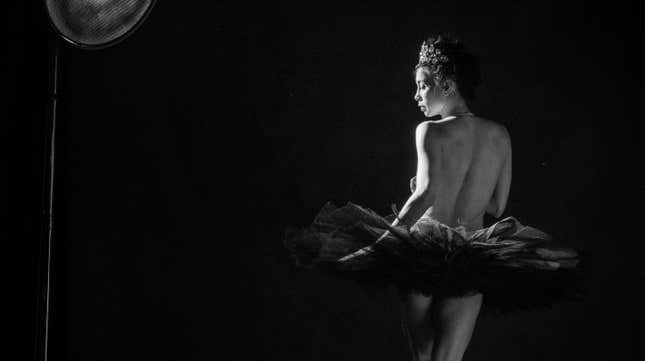Asian American Ballerina Georgina Pazcoguin Unexpectedly Makes History
Pazcoguin is the first AAPI soloist at the City Ballet to dance the role of Polyhymnia in the company's presentation of ‘Apollo.’ It almost didn't happen.
In Depth

Georgina Pazcoguin is no stranger to making history. She’s New York City Ballet’s first Asian American woman to be promoted to soloist. In her 19 years at one of the most influential ballet companies in the world, Mikhail Baryshnikov has called her “always arresting” onstage, and she was recently awarded the title of Kennedy Center’s Next 50 for her work advancing AAPI representation in the field of ballet. It shouldn’t come as a surprise that she has, again, made history this weekend during a performance of Balanchine’s 1928 ballet “Apollo.” Still, this news is a surprise to Pazcoguin.
With its original premiere in Paris and its City Ballet premiere in 1951, “Apollo” is the oldest Balanchine ballet in City Ballet’s repertory. The ballet tells the story of Apollo as a young god on a search for adulthood, as guided by the muses of mime, poetry, and dance. Principal dancer Tiler Peck, who has danced the role of Terpsichore (the muse of dance), has mentioned that her muse’s solo is quite difficult to perform: It doesn’t have any “firework moments.” For Polyhymnia, the muse of mime and one of the most renowned roles for women in this ballet, however, the “firework moment” appears to be Pazcoguin’s casting itself: She’s now the first company AAPI soloist to dance the role of this particular muse in City Ballet history.
As Pazcoguin tries to express her gratitude over the phone, she trips over her words as she tries to process in real time the gravity of the accomplishment. While she has worked doggedly for a moment like this one, her latest feat wouldn’t have happened if not for the misfortune of other company members.
The field of American ballet has long been littered with one-dimensional caricatures and garish tropes of the Asian American experience. The most widely consumed ballet in the states, Tchaikovsky’s “The Nutcracker” for decades incorporated wildly exaggerated and historically incorrect Asian characters. One of which was, in Pazcoguin’s words, “dressed as a coolie… in his rice paddy hat, Fu Manchu mustache, and slanty-eye yellowface makeup, while doing split jumps.” To make matters worse, the character is often wheeled out of a tea box, instructed to bow repeatedly, and dressed in a geisha wig—a choice Pazcoguin has called “the icing on this racist cake.”
Every December, conversations about how the AAPI community could be better represented, let alone included in ballet at all, has sparked an uproar of dancers and audience members alike. But the rage quickly dies down, giving way to submission and apathy that leaves AAPI ballet dancers in a bit of a repeated tailspin. It wasn’t until 2017 when Pazcoguin joined the City Ballet’s new state-mandated diversity committee that she was able to begin voicing her concerns within the institution and dismantling the caricatures that had haunted her Filipina American upbringing. Two years later, the City Ballet cast a biracial Trinidadian Filipino girl as Marie, the lead character in “The Nutcracker.”
The ongoing exclusion of Asian American women in ballet is, in part, why Pazcoguin’s casting is something to marvel at, but Pazcoguin says she wasn’t initially cast in the role. Instead, she’d been notified last-minute that she would be stepping in as an understudy after one dancer became ill and another suffered an injury.
“It’s immensely humbling knowing you are not first, second, third or even fourth choice to dance a role and suddenly find yourself thrown into a final complete [rehearsal] with no stage lights or costume with a cast who is so wonderful and your directors crossing their fingers that you can do them this solid, earning their trust one literal step at a time,” Pazcoguin told Jezebel. “It’s awe inspiring. It’s suddenly dig deep time.”
Pazcoguin says she believes she was ultimately cast in the role because she had performed the Polyhymnia variation multiple times for other small gig companies, although her last time doing so onstage was in 2018…nearly four years ago. Of course, she was heartbroken that her moment to shine had arisen from other dancers’ pain, but, as they say, the show must go on. She was prepared for the variation, but the opening and finale? That was a different story. On Saturday, she attended an emergency rehearsal, and by that evening, she found herself in front of an audience, nervously awaiting her moment in the wings.
“All of a sudden, not only are you getting thrown on, but you’re getting thrown into one of the most iconic Balanchine ballets during the Stravinsky festival, and I just kept on saying, ‘Thank you, thank you,’” she told me over the phone on Monday. “The fact that history was made this weekend…I still have not even processed that. I think we’re just grateful to be able to keep the show going, and during APA heritage month (APAHM) in May no less, it’s just…what a kismet of different things.”
-

-

-

-

-

-

-

-

-

-

-

-

-

-

-

-

-

-

-

-

-

-

-

-

-

-

-

-

-

-

-

-

-

-

-

-

-

-

-

-








































